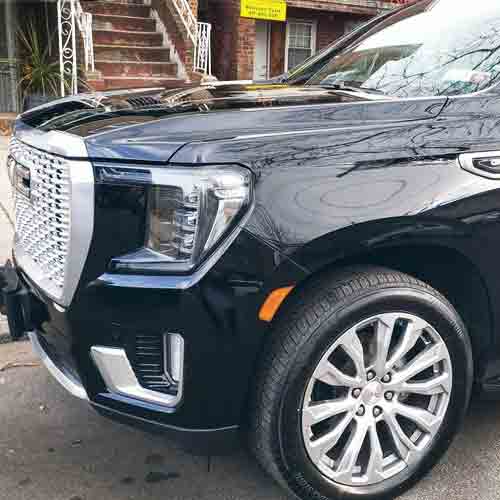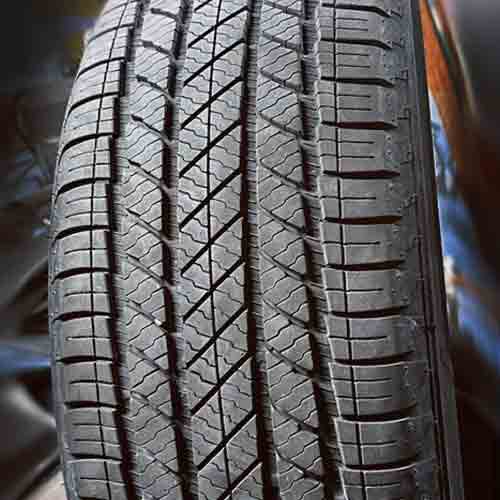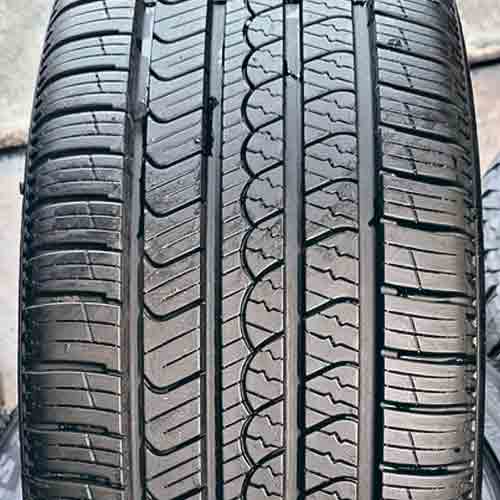In the SUV Touring All-Season category, you’ll find both the Pirelli Scorpion AS Plus 3 and the Bridgestone Alenza AS Ultra, designed for drivers of crossovers, SUVs, and pickup trucks seeking a comfortable and confident all-season driving experience. Let’s explore which tire suits your needs more effectively.

Main Highlights
So overall, the Scorpion AS Plus 3 is better at:
- Dry-Road Braking: Offering shorter braking distances due to its solid central rib design.
- Ice Traction: With its asymmetric tread pattern and variety of sipes for improved grip.
- Comfort in Ride: Providing a smoother ride with its softer and more flexible tread.
Whereas the Alenza AS Ultra is better at:
- Wet-Road Handling: Demonstrating superior steering response and overall handling in wet conditions, aided by well-designed central grooves.
- Performance in Light Snow: With its tread design optimized for better snow-to-snow contact.
- Noise Reduction: Thanks to its QuietTrack technology and special rubber composition.
Tread Features
The Bridgestone Alenza AS Ultra showcases a symmetric tread pattern, which is mostly common for SUV all-season tires.

Now, the standout feature of its tread is its central (most) rib, showcasing a wide structure with chamfered edges and abundant wave-like siping.
See how this rib is also neatly divided by a longitudinal slit.
Adjacent to this are ribs that offer more space and thicker lateral voids with offset edges.
These three central ribs together create four circumferential channels, each with a unique pattern that enhances the tire’s ability to dampen noise.
The outer shoulder blocks of the Alenza are notably straightforward, forming curved lateral voids and equipped with linear sipes running both horizontally and vertically.
This design ensures a stable and smooth riding experience.
Shifting focus to the Pirelli Scorpion, this tire opts for a completely different asymmetric tread design.

Also featuring a 5-rib layout, its central rib is a continuous runner with a notably more aggressive look.
This rib is marked by curved in-groove notches, dividing the siping into two patterns: wave-like and linear.
The adjacent ribs also differ in their siping designs, although they maintain slightly curved lateral voids that interconnect with the circumferential grooves.
Moving towards shoulders, they although may seem similar to AS Ultra, they are bit different.
I mean they offers similar mix of lateral and longitudinal slits, they are slightly more aggressive, and less streamlined.
Moreover, all these lugs here also feature ridges in b/w them, connecting them together, adding to the tire’s stability.
Take a moment to note: I recommend visiting my main all-season tire page as your first step towards finding top-tier AS tires.
Info on Sizes
The Bridgestone Alenza AS Ultra comes in 16 to 21 inches rims, with total of 49 sizes having following specs.
- Speed ratings: H, V and W.
- Load ratings: SL, XL.
- Weight range: 24 to 42 lbs.
- Tread depth: 10/32″ (or 8mm) on all.
- UTQG: 680 A A.
- Treadwear warranty: 80k miles.
- Internally, the tire comes with 2 ply polyester, 2 steel belts, with single nylon cap ply on top.
Review Bridgestone Alenza AS Ultra in greater details.
The Pirelli Scorpion AS Plus 3 comes in 17 to 22 inches wheels. And all of those sizes have following specifications.
- Speed ratings: T, H and V.
- Load ratings: SL and XL.
- Tread depth: 11/32″ on all.
- Weight range: 29 to 42 lbs.
- Treadwear warranty: 70k miles.
- UTQG rating: 800 A A.
- Internally, the Scorpion AS is fortified with 2 layers of polyester, complemented by 2 nylon cap plies and a pair of steel belts.
Review Pirelli Scorpion AS Plus 3 in greater details.
Dry-Road Performance
Dry performance is all about assessing the tire’s linear/lateral grip, and steering response effectively. So let’s take a look at them both one by one.
Linear Grip
Directional grip is essentially the tire’s ability to stick to the roads, while moving in a straight line.
It gets measured through tire’s braking efficacy, and depends on tread’s footprint, particularly from the middle (as this is the area where lugs meet the most with road, as the tire rolls straight).
So, let’s talk about the Scorpion AS Plus 3. I’ve tested it myself, and let me tell you, it’s a game changer.
I mean, Pirelli’s tire here can shorten your braking distance by up to 13 feet compared to the Alenza, depending on the tire size.
The secret sauce? It’s got this continuous, beefy rib right down the middle and a tough base, backed up by a harder layer of rubber underneath. This means you get solid, consistent contact with the road.
As for Alenza AS Ultra, well, this tire falls short, with its more open central rib design.
Plus, it doesn’t have those effective biting edges that you find on the AS Plus 3, where you get these curved in-groove notches, particularly, grabbing the road form every angle.
Overall Handling
Handling in tires boils down to two big things: how well they grip on the sides (lateral grip) and how snappy they are when you steer (steering responsiveness).
Now looking at lateral grip first, both tires are pretty much neck and neck, where you can’t put one tire over the other, (as my lateral g force evaluations tell me).
But, throw steering responsiveness into the mix, and it’s a whole new ball game.
Now, steering’s got three main parts to consider:
- Cornering Entry: Slowing down before you dive into the turn.
- Mid-corner: The trickiest bit, where keeping grip is key to stop the car from sliding out (that’s understeering or oversteering for you).
- Exit: After the corner, where the tire’s ability to straighten up is tested.
Now, when we talk about entering and exiting corners, the Pirelli Scorpion AS Plus 3’s got a bit of an edge. It’s quicker in slowing down before the turn (with its superior linear grip), and the tire steadies itself quicker after the turn, getting back to a straight line, faster.
Needless to say, both of these directly add to the tire’s overall dry handling times.
Though since the real game changer here is the mid cornering phase, the Pirelli, being a bit on the heavier side, lacks here, as it tends to understeer.
So while both tires offer a solid lateral grip, the Bridgestone Alenza AS Ultra takes the lead (literally), providing you with faster lap times on average.
For Your Info: The difference between both tires here is pretty low, and that goes especially when you run these tires in summer. I actually posted on it in detail here: https://tiredriver.com/are-all-season-tires-good-for-summer/
Winter Traction
When we’re talking about how all-season tires handle winter conditions, there are three main things to look at:
- Acceleration.
- Handling.
- Performance on Different Winter Terrains:.
Now, here we have some mixed results.
The Pirelli is a champ on ice. Thanks to its asymmetric tread pattern, loaded with a bunch of in-groove notches and a mix of wavy and straight sipes, it really bites into the ice, providing you with the highly needed micro-grip.
The Alenza AS Ultra, though, takes the crown in light snow. Its tread design is slightly better for powdery, soft snow.
Its secondary biters on the base of the grooves, particularly, are pretty good at creating snow-to-snow contact, which is the key on light snowy terrains, as snow sticks to itself better than rubber.
So this kind of “contact” creates more friction and better grip.
But overall, if you have to pick one tire here, I’d lean towards the Pirelli, still.
While the Alenza focuses on lasting longer (thanks to its tougher rubber mix), it sacrifices a bit in winter traction. The rubber gets even more rigid in the cold, which isn’t great for grip.
Just a heads-up, though: neither of these tires has the 3-peak mountain snowflake rating, which is something to consider if you’re looking for serious winter performance.
Noise Dampening
When you compare both tires, you’ll notice the Pirelli AS Plus 3 is kind of noisy. This is because its tread pattern acts like an echo chamber. The sound waves get trapped in the grooves and start bouncing around, making more noise.
On the flip side, the Bridgestone Alenza AS Ultra is all about keeping things quiet. It mixes up the tread pattern and uses special rubber to break up the sound waves. This way, the noise cancels itself out, and the rubber helps muffle what’s left.
This is all thanks to the tire’s QuietTrack technology.
Vibrations Comfort
Now, how well a tire can handle those jarring bumps from the road is super important for a comfy ride, of course.
And it’s all about the rubber mix and tread design.
Now, out of both boys here, the Bridgestone Alenza uses a tougher rubber, relatively speaking.
Basically the tire is more focused towards longevity, and so its rubber isn’t so great for soaking up those bumps.
The Pirelli Scorpion AS Plus 3, though, is more about a smooth ride. Its tread is softer and more bendy. This means it can kind of squish around the bumps in the road, soaking up that jarring energy and giving you a smoother feel.
Side Note: Generally, out of all, grand touring tires are comfortable. Why? Well, check this out – https://tiredriver.com/are-all-season-tires-comfortable-and-quiet-enough/
Wet-Road Performance
When it comes to how tires perform on wet roads, it’s all about the design of the grooves and sipes on the tread pattern.
Think of grooves as the big channels that whisk water away from under the tire. Whereas sipes come in later, helping to get ride of leftover moisture. In other words, these sipes (cuts in the tread), act like sponges.
Now out of both tires, the Pirelli AS Plus 3 offers better straight-line grip. Meaning, when you slam the brakes (from 50 mph), it can stop up to 6 feet shorter on average compared to Alenza.
Though overall wet performance is still better on Bridgestone AS Ultra, I believe, as the tire does great where it truly matters, providing you with superior steering response times, especially noticeable in slalom tests.
I mean, comparatively, this tire just responds quicker and more accurately.
So, why is the Alenza better in this regard, even though both tires have decent siping and biting edges? Well, it’s mostly down to how the tire’s central grooves are designed.
They’re interconnected really well, meaning they’re great at getting rid of water quickly from the start. And so less is there for sipes to deal with, resulting in improved overall wet (lateral) traction, and handling.
Closing Remarks
Almost at the finish line in our comparison, let’s see how these two tires are stacking up.
Now, here the Pirelli AS Plus 3 is standing out in dry-road performance, especially in the linear grip, contributing to shorter braking distances.
Moreover, it also offers decent ice performance, due to its various combination of sipes.
However, it tends to be noisier and underperforms in mid-corner handling due to its heavier weight.
The Bridgestone tire, on the other hand, shines in wet-road performance, where you get better wet traction and resistance to hydroplaning. And yes it also leads in terms of snow handling.
Other than this, the tire is quieter off the two, and offers greater tread longevity, and efficacy in absorbing smaller road bumps, though in terms of larger ones, Pirelli takes the lead.
Though it can improve slightly in terms of fuel economy.
Hi Ozmen,
Thanks for the great reviews. These are the two tires on my short-listed. For a 2015 RX350 AWD mostly city and highway driving, dry, wet, and low milage on snow. Appreciate your recommendation between the two based on the SUV and driving situations.
Thank you!
Go with the Scorpion AS Plus 3.